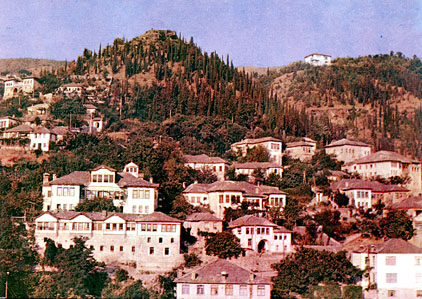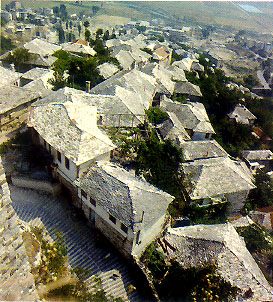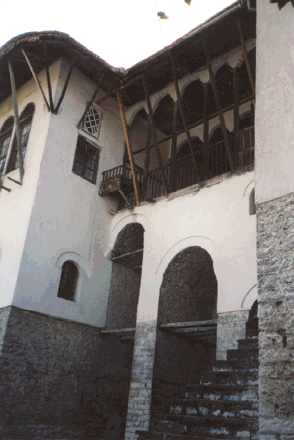Albania
> Gjirokastra
A city in southern Albania with an ancient history,
that lies on the hills of Mali i Gj'r'
(The Wide Mountain), on the eastern side of the
valley of Drinos. Gjirokastra's (pronounced: Gee-roh'-kah'-strah')
population is 30,000.

A view of the town |
Traces
of old settlements date back to the first century
B.C. Because of its favorable position, protected
by the high hills and crossed by major routes that
lead to the inner parts of the country in the north
and the Ionian Sea in the west, it was turned into
a castle (The Castle of Gjirokastra), which became
the nucleus for its growth. Its appearance as a
city began in the 13th century, and it is mentioned
in Byzantine writings as Argyropolihne (the city
of Argyro). Around this year is when buildings began
to emerge on the hills surrounding the castle walls.
It became part of the Despotate of Epirus, and in
the 14th century it was the center of the Albanian
feudal family Zenebish'. The Ottoman Turks took
the city in 1417. Due to its awkward position under
Ottoman rule, the city had only 163 buildings in
1432. It began to prosper in the 16th century, when
it became the center of the Sanjak of Delvina.

|
Gjirokastra
gained its role as an important center during the
17th century, and it prospered during the years
1800-1830, when new houses were built, with high
architectural and artistic value. The Pazari
i Vjet'r� (Old Bazaar) and Hazmurat�
quarters, located on two crests parallel to each
other, are the places where the characteristic Gjirokastra
houses were built the most. The present bazaar,
at the center of the town, was first built in the
17th century. It was set ablaze in the 19th century
and was rebuilt with carved stone to match the houses
surrounding it. The Palorto� and Manalat�
quarters have monumental collections of houses with
their characteristic dimensions and walls of uniform
blocks. Houses of the Dunavat� quarters
are decorously conjugated with their sites, and
in the Cfaka� quarters the shapes of
the buildings are in harmony with the greenery.
The Gjirokastra house is one of the most distinguished
style of the Albanian house, which is represented
in three variations. The exterior appearance combines
the sternness it projects with the gracefulness
of its windows, its lobby (Ťardak), the small columns
that hold the wide shelters, sometimes with paintings
on them. In many cases the interiors have sculptured
wood. The high architectural value of the houses
are a reflection of the nature of Albanian towns
from the Middle Ages through the 20th century.

Museum of History in Gjirokastra (photo by
Dorothy Howells) |
During the 19th century, Gjirokastra played an important
role in the Albanian liberation movement of that
period, it was the site of the Assembly of Gjirokastra,
which was held in July, 1880.
The city developed after World War II, and today
is an economic, cultural, and educational center
of southern Albania. Its main fields of production
are food, clothing, tobacco, and metals. Gjirokastra
has the "A. Z. ,ajupi" Cultural Center with a
professional theater, gallery of arts, and 23
museums, of which the most distinguished are The
National Museum of Arms and the Gjirokastra Museum
of the Rilindja� (the Albanian National
Liberation Movement of the 19th century). Gjirokastra
publishes several newspapers, including ones in
Greek, since it is home to part of the Greek minority
of Albania.
Every five years since the year 1968, Gjirokastra
is the site of the National Folk Festival, which
brings together folk musicians and dancers from
the entire country, and lately from Kosova and
the Albanian populated regions of FYR of Macedonia.
|